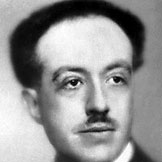
Biografia estratta da Nobel Lectures, Physics 1922-1941.
![]() 1929 Premio Nobel per la Fisica
1929 Premio Nobel per la Fisica
Prince Louis-Victor de Broglie of the French Academy, Permanent Secretary of the Academy of Sciences, and Professor at the Faculty of Sciences at Paris University, was born at Dieppe (Seine Inférieure) on 15th August, 1892, the son of Victor, Duc de Broglie and Pauline d'Armaillé. After studying at the Lycée Janson of Sailly, he passed his school-leaving certificate in 1909. He applied himself first to literary studies and took his degree in history in 1910. Then, as his liking for science prevailed, he studied for a science degree, which he gained in 1913. He was then conscripted for military service and posted to the wireless section of the army, where he remained for the whole of the war of 1914-1918. During this period he was stationed at the Eiffel Tower, where he devoted his spare time to the study of technical problems.
At the end of the war Louis de Broglie resumed his studies of general physics. While taking an interest in the experimental work carried out by his elder brother, Maurice, and co-workers, he specialized in theoretical physics and, in particular, in the study of problems involving quanta. In 1924 at the Faculty of Sciences at Paris University he delivered a thesis Recherches sur la Théorie des Quanta (Researches on the quantum theory), which gained him his doctor's degree. This thesis contained a series of important findings which he had obtained in the course of about two years. The ideas set out in that work, which first gave rise to astonishment owing to their novelty, were subsequently fully confirmed by the discovery of electron diffraction by crystals in 1927 by Davisson and Germer; they served as the basis for developing the general theory nowadays known by the name of wave mechanics, a theory which has utterly transformed our knowledge of physical phenomena on the atomic scale. After the maintaining of his thesis and while continuing to publish original work on the new mechanics, Louis de Broglie took up teaching duties. On completion of two year's free lectures at the Sorbonne he was appointed to teach theoretical physics at the Institut Henri Poincaré which had just been built in Paris.
The purpose of that Institute is to teach and develop mathematical and theoretical physics. The incumbent of the chair of theoretical physics at the Faculty of Sciences at the University of Paris since 1932, Louis de Broglie runs a course on a different subject each year at the Institut Henri Poincaré, and several of these courses have been published. Many French and foreign students have come to work with him and a great deal of doctorate theses have been prepared under his guidance. Between 1930 and 1950, Louis de Broglie's work has been chiefly devoted to the study of the various extensions of wave mechanics: Dirac's electron theory, the new theory of light, the general theory of spin particles, applications of wave mechanics to nuclear physics, etc. He has published numerous notes and several papers on this subject, and is the author of more than twenty-five books on the fields of his particular interests. Since 1951, together with young colleagues, Louis de Broglie has resumed the study of an attempt which he made in 1927 under the name of the theory of the double solution to give a causal interpretation to wave mechanics in the classical terms of space and time, an attempt which he had then abandoned in the face of the almost universal adherence of physicists to the purely probabilistic interpretation of Born, Bohr, and Heisenberg. Back again in this his former field of research, he has obtained a certain number of new and encouraging results which he has published in notes to Comptes Rendus de l'Académie des Sciences and in various expositions. After crowning Louis de Broglie's work on two occasions, the Academie des Sciences awarded him in 1929 the Henri Poincaré medal (awarded for the first time), then in 1932, the Albert I of Monaco prize.
In 1929 the Swedish Academy of Sciences conferred on him the Nobel Prize for Physics "for his discovery of the wave nature of electrons".
In 1952 the first Kalinga Prize was awarded to him by UNESCO for his efforts to explain aspects of modern physics to the layman. In 1956 he received the gold medal of the French National Scientific Research Centre. He has made major contributions to the fostering of international scientific co-operation. Elected a member of the Academy of Sciences of the French Institute in 1933, Louis de Broglie has been its Permanent Secretary for the mathematical sciences since 1942.
He has been a member of the Bureau des Longitudes since 1944.
He holds the Grand Cross of the Légion d'Honneur and is an Officer of the Order of Leopold of Belgium. He is an honorary doctor of the Universities of Warsaw, Bucharest, Athens, Lausanne, Quebec, and Brussels, and a member of eighteen foreign academies in Europe, India, and the U.S.A. Professor de Broglie's most important publications are: Recherches sur la théorie des quanta (Researches on the quantum theory), Thesis Paris, 1924.
Ondes et mouvements (Waves and motions), Gauthier-Villars, Paris, 1926. Rapport au 5e Conseil de Physique Solvay, Brussels, 1927.
La mécanique ondulatoire (Wave mechanics), Gauthier-Villars, Paris, 1928.
Une tentative d'interprétation causale et non linéaire de la mécanique ondulatoire: la théorie de la double solution, Gauthier-Villars, Paris, 1956. English translation: Non-linear Wave Mechanics: A Causal Interpretation, Elsevier, Amsterdam, 1960. Introduction à la nouvelle théorie des particules de M. Jean-Pierre Vigier et de ses collaborateurs, Gauthier-Villars, Paris, 1961.
English translation: Introduction to the Vigier Theory of elementary particles, Elsevier, Amsterdam, 1963. Étude critique des bases de l'interprétation actuelle de la mécanique ondulatoire, Gauthier-Villars, Paris, 1963.
English translation: The Current Interpretation of Wave Mechanics: A Critical Study, Elsevier, Amsterdam, 1964. Louis de Broglie died on March 19, 1987.

